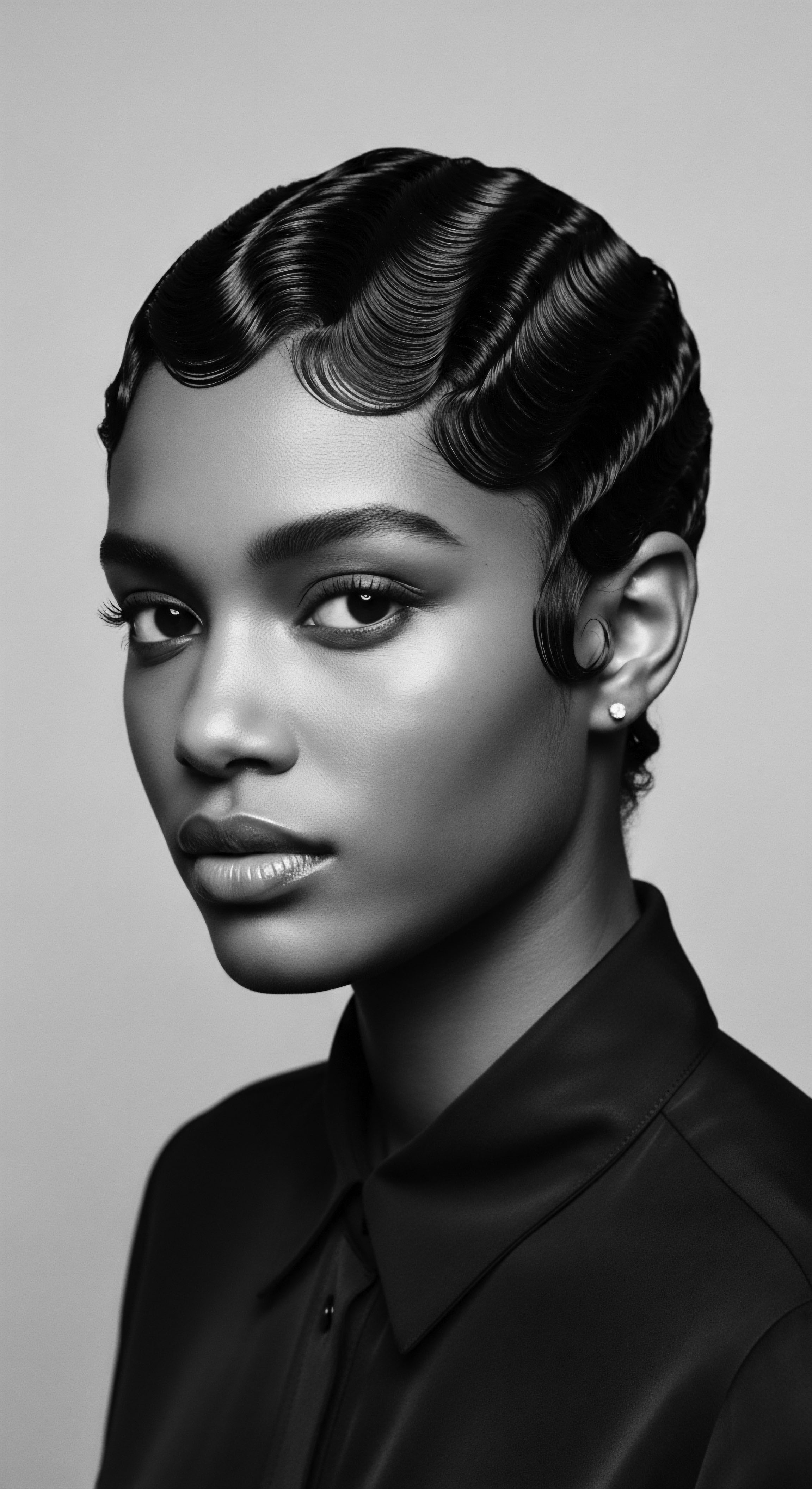
Fundamentals
The concept of Textured Hair Products, at its most elemental articulation, pertains to the specialized formulations crafted to cleanse, condition, style, and sustain the well-being of hair exhibiting natural curls, coils, and waves. This encompasses the full spectrum of hair types found within individuals of Black and mixed-race ancestries, where the helical structure of the hair strand presents unique physiological characteristics and care requisites. From the very outset, understanding these products necessitates a gaze backward, recognizing that their fundamental purpose echoes ancient traditions of care, a continuous thread connecting past wisdom to present innovations.
These products are not merely cosmetic; they represent a convergence of biological understanding and cultural practices passed down through generations. The inherent dryness and susceptibility to breakage often associated with Afro-textured hair , stemming from its distinctive elliptical follicle shape and tight coiling which impedes natural oil distribution down the hair shaft, necessitated specific solutions long before modern chemistry emerged. Early care, a foundational element in understanding the modern product landscape, relied upon the richness of the earth’s bounty and communal knowledge.
Textured Hair Products, at their core, are contemporary extensions of ancient communal practices, crafted to honor and nourish the unique patterns of coiled and curly hair.
The initial engagement with Textured Hair Products often begins with basic cleansing and conditioning. Shampoos for textured hair are formulated with gentler surfactants to prevent stripping natural oils, while conditioners are generally richer, aiming to provide intensive moisture and aid in detangling. This approach reflects a deep-seated understanding of moisture retention, a practice evident in ancestral regimens that utilized natural butters and oils to seal hydration within the hair strand. These early applications, while perhaps lacking precise scientific terminology, were rooted in keen observation of hair’s intrinsic needs.

A First Glimpse at Purpose
At a foundational level, Textured Hair Products serve several core functions for individuals new to understanding these specialized offerings. Their primary intent is to address the specific structural characteristics of highly coiled or wavy hair patterns, which often differ significantly from straight hair textures. These products seek to maintain moisture, reduce friction, and provide flexibility for styling, all while respecting the natural integrity of the hair.
- Moisture Retention ❉ Products such as rich conditioners, leave-in treatments, and styling creams focus on infusing and sealing hydration, addressing the inherent dryness often associated with tighter curl patterns.
- Detangling ❉ The unique structure of textured hair makes it prone to tangling and knotting; specialized detangling shampoos and conditioners assist in smoothing the cuticle and reducing friction during manipulation.
- Styling Support ❉ Gels, mousses, and custards aid in defining natural curl patterns, reducing frizz, and providing hold for various styles, from wash-and-gos to braids and twists.
Historically, the care of textured hair was a communal activity, deeply woven into the fabric of daily life in many African societies. This shared responsibility ensured that knowledge of effective ingredients and techniques was transmitted from elder to younger generations. The contemporary range of Textured Hair Products, in essence, seeks to bottle this communal wisdom, offering accessible tools for individual care while still inviting connection to a broader heritage of self-adornment and hair health.
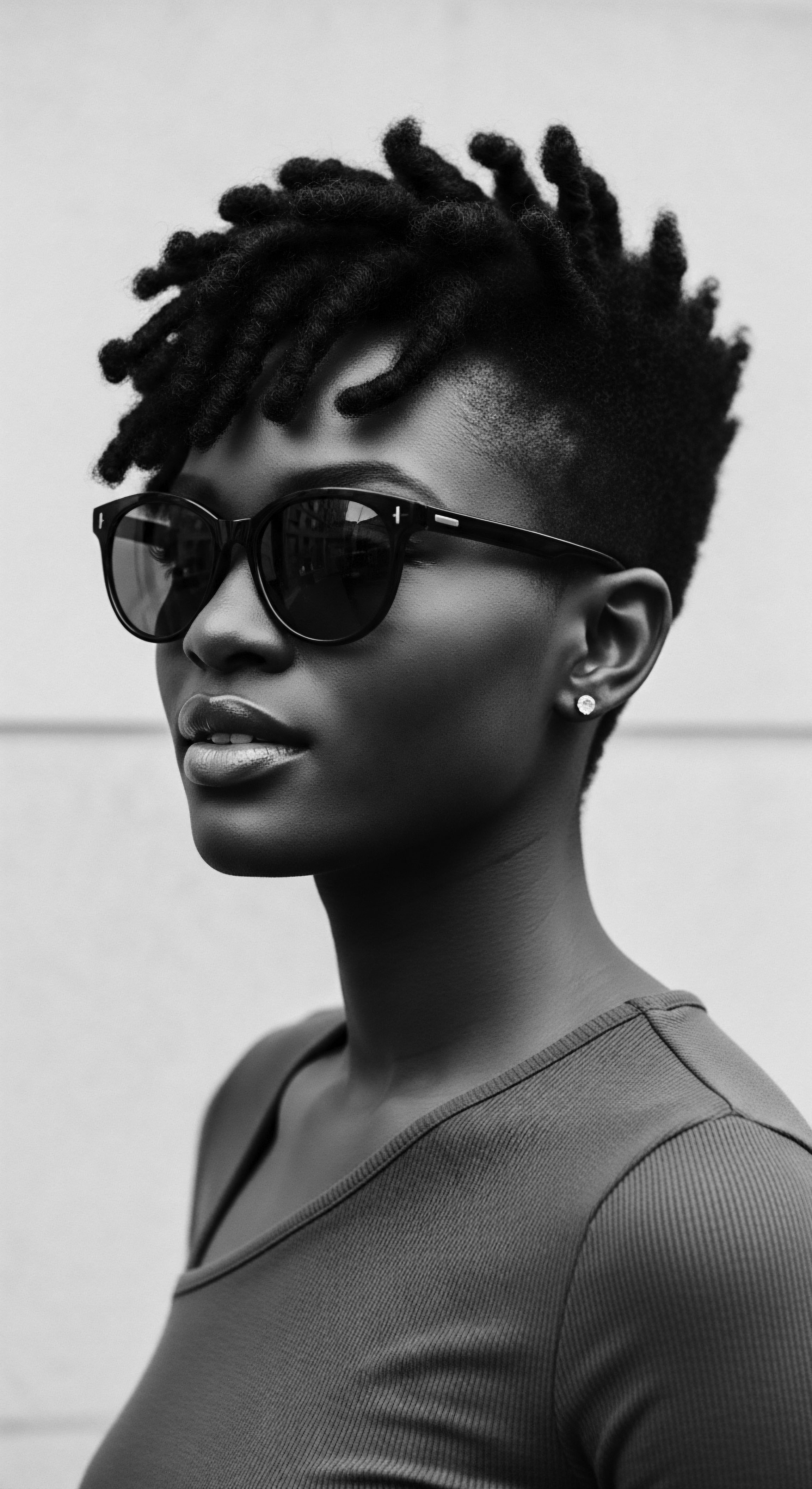
Intermediate
Moving beyond the foundational tenets, an intermediate understanding of Textured Hair Products unfolds into a richer appreciation of their composition, their interaction with the unique biology of curly and coily hair, and their profound cultural dimensions. Here, the meaning of these products deepens, becoming inextricably linked to the historical journey of Black and mixed-race communities and their evolving relationship with hair as a marker of identity, resilience, and beauty.
The distinctive helical structure of Afro-textured hair means that its follicles grow at an angle, resulting in a more elliptical cross-section for the hair strand. This configuration limits the even distribution of sebum, the natural oil produced by the scalp, along the entire length of the hair fiber. Consequently, Afro-textured hair tends to be inherently drier and more susceptible to mechanical damage compared to straight hair. Textured Hair Products are meticulously formulated to counteract these biomechanical realities, offering targeted solutions that replenish moisture, fortify the strand, and enhance manageability without resorting to harsh chemical alterations.
Consider the historical trajectory of hair care within the African diaspora, where the very act of hair dressing served as a means of communication, indicating social status, marital standing, age, and tribal affiliation in pre-colonial societies. When enslaved Africans were forcibly transported to the Americas, their intricate hairstyles were often shorn, a deliberate act of dehumanization and cultural erasure. In response, care practices persisted, often using whatever scarce resources were available, from bacon grease to kerosene, a testament to the enduring human spirit and the unwavering desire to preserve a sense of self. This historical context lends profound significance to the modern array of Textured Hair Products, as they represent a reclamation and a continued celebration of ancestral beauty rituals.

The Evolution of Ingredients and Rituals
The evolution of Textured Hair Products reflects a continuous dialogue between traditional knowledge and scientific understanding. Ancestral practices relied heavily on natural elements available in the immediate environment. For instance, shea butter , derived from the nuts of the Karité tree native to West Africa, has been revered for centuries as a potent moisturizer for both skin and hair due to its rich content of fatty acids and vitamins.
Archaeological evidence suggests its use dates back at least to A.D. 100 in western Burkina Faso, a testament to its long-standing significance in regional beauty practices (Gallagher, 2016).
Other traditional components, such as various plant oils, herbs, and even certain clays, played roles in cleansing, conditioning, and styling. These natural components provided properties like moisture sealing, scalp soothing, and detangling. Today’s Textured Hair Products often integrate these very same ancestral ingredients, albeit refined and combined with modern cosmetic science to enhance efficacy and stability.
Each bottle of modern textured hair product carries the whispers of ancient hands, a continuum of care passed down through the ages.
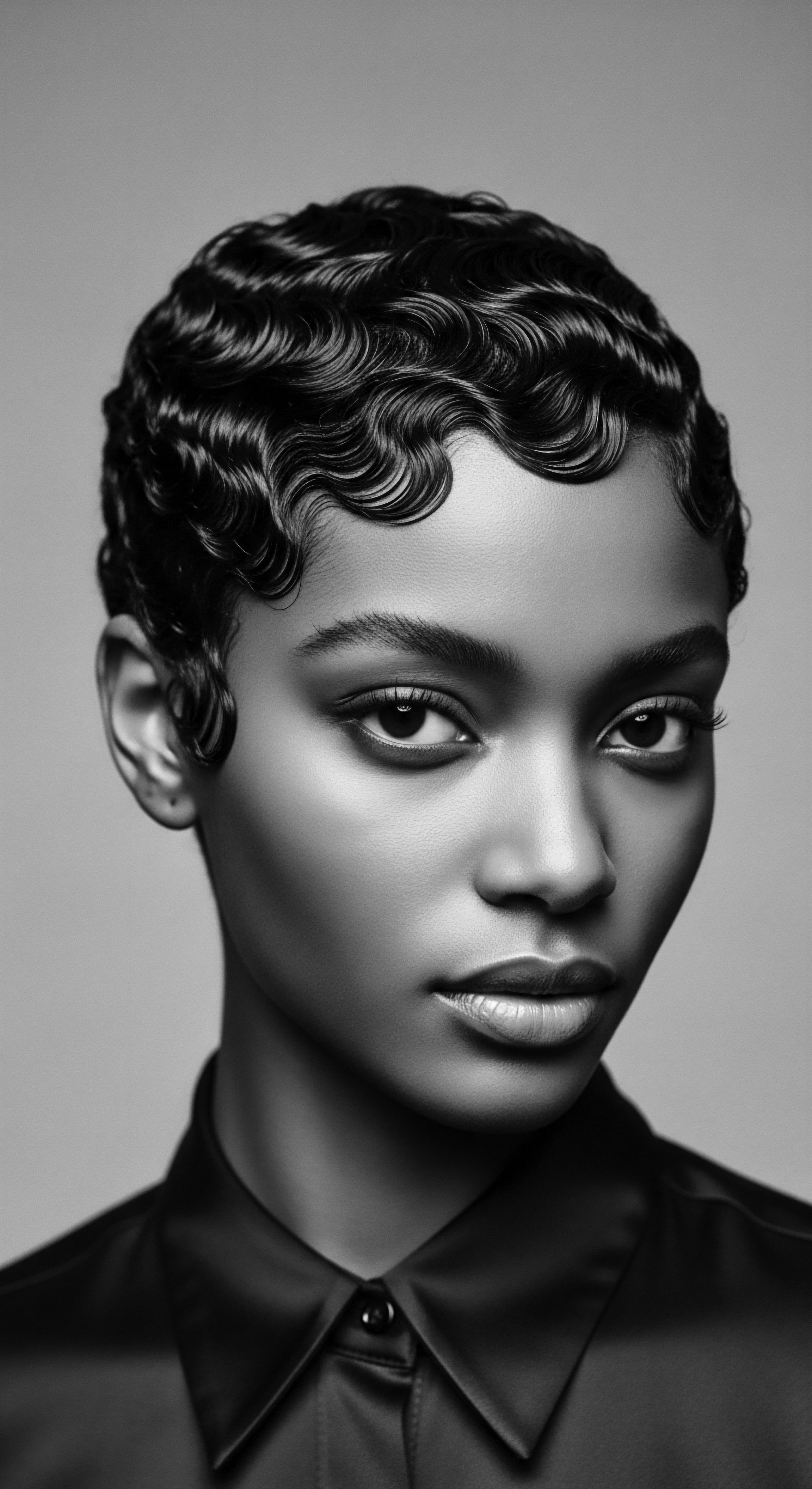
Key Product Categories and Their Purpose
The intermediate understanding recognizes distinct product categories beyond basic shampoo and conditioner, each designed to address specific needs of textured hair.
- Leave-In Conditioners ❉ Applied after washing, these products remain on the hair to provide continuous hydration and serve as a base for styling, acting as a crucial barrier against moisture loss throughout the day.
- Hair Butters and Oils ❉ Often featuring ingredients like Shea Butter, Cocoa Butter, or jojoba oil , these are used to seal in moisture, add shine, and provide softness, reflecting ancient uses of natural fats for hair nourishment.
- Styling Creams and Gels ❉ Formulations designed to define curl patterns, reduce frizz, and offer hold for styles like twists, braids, or wash-and-gos, allowing for sculptural expression reminiscent of elaborate traditional African hairstyles.
The choices made by consumers in selecting Textured Hair Products are not solely about aesthetics or functionality; they are often deeply personal acts of self-affirmation, particularly for Black and mixed-race individuals. The growing movement toward embracing natural textures represents a deliberate rejection of Eurocentric beauty standards that historically promoted chemical straightening as the ideal. The products chosen become part of a larger conversation about identity, heritage, and the power of self-definition in the face of persistent societal pressures.
| Historical Practices (Pre-Colonial Africa) Application of natural butters (e.g. shea butter), plant oils, and herbs directly to hair and scalp for moisture, protection, and styling. |
| Modern Textured Hair Products Formulations incorporating ancestral ingredients like shea butter, coconut oil, jojoba oil, and various botanical extracts in shampoos, conditioners, and stylers. |
| Historical Practices (Pre-Colonial Africa) Communal hair grooming rituals, where knowledge of remedies and styling techniques was passed down through generations. |
| Modern Textured Hair Products Products designed for individual home use, yet often supported by online communities and educational content that fosters a sense of collective learning and shared heritage. |
| Historical Practices (Pre-Colonial Africa) Hair adorned with cowrie shells, beads, and precious metals, signifying status, wealth, and spiritual connection. |
| Modern Textured Hair Products Styling products that enable intricate protective styles (braids, twists, locs) that continue to serve as expressions of cultural pride and individual artistry. |
| Historical Practices (Pre-Colonial Africa) The journey from ancient communal care to contemporary personal regimens illustrates a profound continuity in honoring textured hair's unique requirements and cultural significance. |

Academic
The academic definition of Textured Hair Products transcends a mere cataloging of items; it represents a sophisticated conceptual framework that encompasses biochemical properties, dermatological implications, cultural semiotics, and socio-economic dynamics, all viewed through the lens of a rich and often challenging heritage. The meaning of these products is thus deeply embedded in the historical narrative of textured hair, particularly within Black and mixed-race communities, where hair has consistently served as a potent site of identity negotiation, resistance, and self-affirmation. This exploration demands a rigorous, research-backed understanding of how scientific advancements intersect with ancestral wisdom and lived experience.
Textured hair, characterized by its curvilinear and often tightly coiled follicular architecture, presents a unique set of biophysical attributes. The elliptical cross-section of the hair shaft and the angled growth from the scalp impede the uniform distribution of sebum along the strand, contributing to inherent dryness and a predisposition to breakage. Furthermore, the points of curvature within the hair fiber represent areas of mechanical weakness, making textured hair more susceptible to damage from manipulation and environmental stressors. Textured Hair Products are specifically formulated to mitigate these vulnerabilities.
They often employ humectants to draw moisture from the environment, emollients to soften and smooth the hair cuticle, and occlusives to seal in hydration. The chemical composition of these products is meticulously balanced to provide slip for detangling, reduce friction during styling, and fortify the hair’s structural integrity.
The historical context within which these products have developed is paramount. The legacy of chattel slavery, for example, saw the deliberate destruction of traditional African hair practices and the imposition of Eurocentric beauty standards. Enslaved Africans were often forced to cover or cut their hair, erasing a vital marker of identity and cultural connection.
This historical subjugation led to the pervasive concept of “good hair” (straighter, looser curls) versus “bad hair” (kinky, coily textures) within the African diaspora, fostering an internalized pressure to chemically alter hair to conform to dominant societal norms. The early 20th century witnessed the rise of pioneering Black entrepreneurs who responded to this societal demand, developing products that offered solutions for both hair health and straightening.
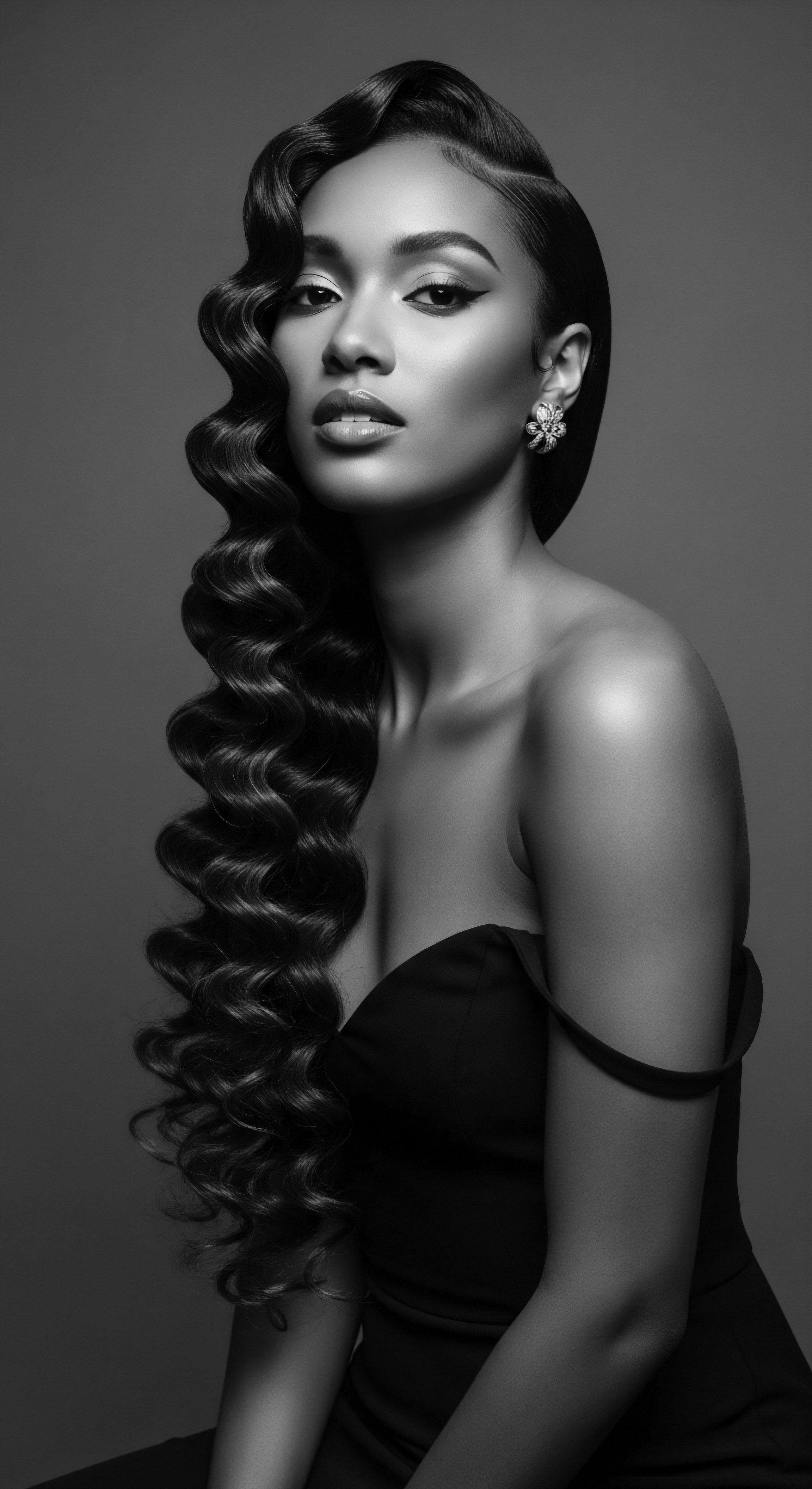
The Socio-Economic Tapestry of Textured Hair Products
The emergence of figures like Madam C.J. Walker (born Sarah Breedlove) and Annie Turnbo Malone stands as a profound testament to the intertwined nature of hair care, heritage, and economic empowerment within the Black community. Madam C.J.
Walker, recognized as one of America’s first self-made female millionaires, did not invent the hot comb, but her strategic promotion and product lines, such as “Madam Walker’s Wonderful Hair Grower,” revolutionized hair care for Black women in the early 1900s. Her methodology, the “Walker Method,” combined a heated comb with pomades to achieve straightened styles, addressing prevailing beauty ideals that often linked straight hair to social and economic mobility.
The historical trajectory of Textured Hair Products embodies a narrative of resilience, ingenuity, and a profound commitment to community well-being in the face of systemic adversity.
Walker’s enterprise, the Madam C.J. Walker Manufacturing Company, created a vast network of thousands of Black women who served as sales agents, providing not only employment but also a pathway to economic independence in a discriminatory society. This distribution model was revolutionary, empowering women to build their own businesses and become agents of change within their communities.
Annie Malone, another pioneering entrepreneur, established the Poro College Company in 1902, offering training in cosmetology and creating a broad distribution system through “Poro agents.” Her “Wonderful Hair Grower” also aimed to improve scalp health and hair growth, predating Walker’s similar product. These ventures were not just about products; they were about social uplift, education, and fostering a sense of dignity through self-care.
The political dimensions of Textured Hair Products became particularly salient during the Civil Rights and Black Power movements of the 1960s and 1970s. The Afro hairstyle, a direct rejection of chemical straightening and an assertion of Black identity, became a powerful symbol of defiance and cultural pride. This period saw a shift in demand, prompting the development of products that supported natural textures rather than altering them. This historical pivot underscores how the market for Textured Hair Products is not merely driven by consumer preference but is deeply influenced by broader social and political currents that redefine beauty standards and cultural affirmation.

Analyzing Product Efficacy and Biocompatibility
From an academic perspective, the efficacy of Textured Hair Products is evaluated through their interaction with the hair’s unique biomechanical properties and their ability to address specific concerns. These products often contain lipid-rich ingredients (e.g. fatty acids, ceramides) to lubricate the hair shaft and reduce inter-fiber friction, which is crucial for preventing breakage in tightly coiled hair. Protein hydrolysates are often included to temporarily strengthen the hair cuticle, providing a protective layer against environmental and mechanical stress.
The importance of moisture management in textured hair care cannot be overstated. Products that create a hydrophobic film on the hair surface, such as those containing silicones or certain natural oils, can effectively reduce water loss, a common challenge for Afro-textured hair. The debate surrounding ingredients like raw oils and butters in contemporary natural hair communities, for example, often revolves around their ability to penetrate the hair shaft versus merely coating it, impacting true hydration versus surface conditioning. However, traditional practices, such as those of the Basara people of Chad using Chebe powder mixed with oils and fats, demonstrate remarkable success in length retention, suggesting complex interactions beyond simple penetration.
Furthermore, the academic discourse around Textured Hair Products includes an examination of potential health implications. Historically, chemical relaxers, while providing desired straightness, have been associated with scalp irritation, hair loss, and even an increased risk of certain health conditions. This has fueled the natural hair movement’s emphasis on formulations free from harsh chemicals, promoting scalp health and overall hair integrity. The ongoing research into the long-term effects of various ingredients and styling practices reflects a continuous commitment to developing products that are not only aesthetically pleasing but also biologically sound and culturally respectful.
In essence, the academic meaning of Textured Hair Products is a multi-layered construct. It encompasses the intrinsic biology of the hair itself, the historical and socio-political forces that have shaped beauty ideals, the entrepreneurial spirit that forged an industry, and the ongoing scientific inquiry into optimal care. It is a field that constantly bridges the ancient and the modern, seeking to empower individuals through products that honor their heritage while advancing the frontiers of hair science.
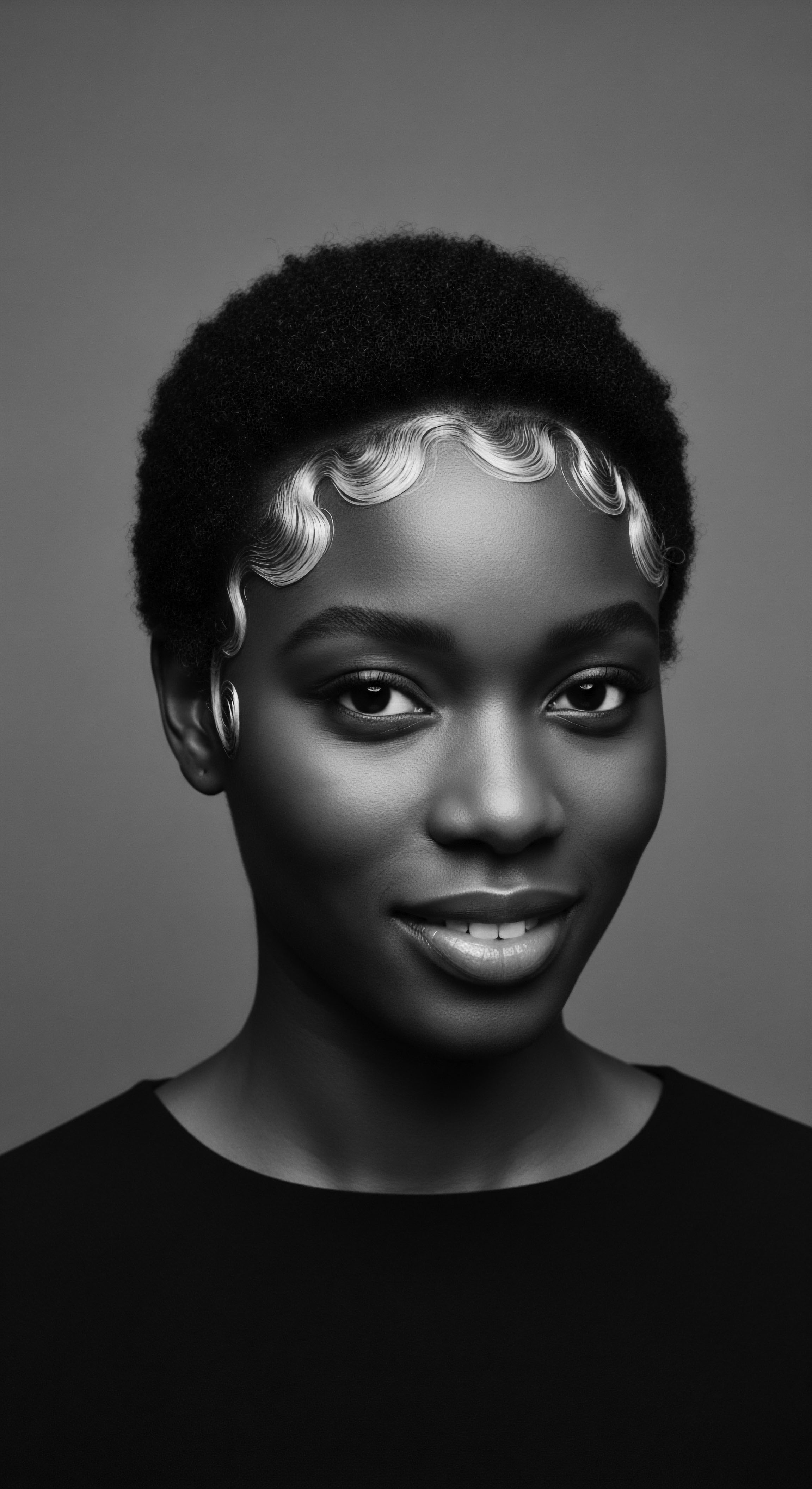
Reflection on the Heritage of Textured Hair Products
As we stand at this juncture, contemplating the multifaceted nature of Textured Hair Products, a poignant truth reveals itself ❉ these formulations are far more than mere commercial goods. They are vessels of memory, embodying the enduring spirit of generations who tended to their coils and curls with intentionality and reverence. The path from ancient plant-based elixirs to the scientifically advanced offerings of today is not a linear progression from primitive to perfected; rather, it is a circular dance, where ancestral wisdom continually informs and enriches contemporary understanding.
The tender thread of care, once spun in communal settings under the warm African sun, where hands braided stories into strands and natural butters offered solace and strength, continues in the quiet moments of modern self-care. Each application of a leave-in conditioner, each definition of a curl with a carefully chosen styling cream, resonates with the echoes from the source. It is a quiet rebellion against historical attempts to erase or diminish the inherent beauty of textured hair, a reclamation of a heritage that refused to be silenced.
In every carefully chosen Textured Hair Product, we rediscover a piece of our ancestral story, connecting us to a legacy of profound beauty and unwavering resilience.
The unbound helix of textured hair, so resilient and diverse, remains a powerful metaphor for identity itself. The products designed for it celebrate this diversity, allowing for an expansive range of expressions that honor personal aesthetic while reaffirming a collective cultural pride. This is a journey of self-discovery, of embracing what is naturally given, and of finding empowerment in one’s own reflection.
The marketplace for Textured Hair Products, therefore, transforms into a sacred space, a modern apothecary where individuals can access the tools to nurture their hair, connecting them not only to their biological makeup but to the profound, living archive of their ancestral story. The care of textured hair, supported by these thoughtful creations, remains an intimate act of heritage preservation, a soulful testament to beauty’s enduring power.

References
- Gallagher, D. (2016). Researchers get lathered up over Shea butter’s history. Journal of Ethnobiology, 36(1).
- Heaton, S. (2021). Heavy is the Head ❉ Evolution of African Hair in America from the 17th c. to the 20th c. The Library of Congress.
- Ndichu, J. & Upadhyaya, S. (2019). “Going natural” ❉ Black women’s identity project shifts in hair care practices. ResearchGate.
- Sieber, R. & Herreman, F. (2000). Hair in African Art and Culture. ResearchGate.
- Thomas, T. (2013). The Evolution Of The Natural Hair Movement. Refinery29.
- Walker, Madam C.J. (2007). Madam C.J. Walker ❉ Entrepreneur, Leader, and Philanthropist. Harvard Business School Case 807-145.
- White, S. & White, J. (1995). Slave Narratives of the Era of American Revolution. Oxford University Press.
- Essel, E. (2021). Historical Roots of Makai Hairstyle of Elmina People of Ghana. International Journal of Arts and Social Science, 4(1).
- Beautylish. (2025, February 5). Black History Month ❉ 9 Hair Industry Innovators Who Made Major Waves.
- JCSU Library. (n.d.). Inventor Highlight-Madame C. J. Walker.
- Malone, A.T. (1920-1927). Poro College Company Souvenir Booklet.
- National Museum of American History. (n.d.). Hair Care.
- CUNY Academic Works. (2014, January 8). Examining the Experiences of Black Women with Natural Hair.
- Smith Scholarworks. (n.d.). Black women’s natural hair care communities ❉ social, political, and cultural implications.
- Ozakawa, M. Sanders Thompson, V.L. Sekayi, D. Robinson, D. & Tate, S. (1987-2011). Multiple studies on historical roots of devaluation of Black hair and preference of Eurocentric aesthetics.
- MDPI. (2023, April 27). The Genomic Variation in Textured Hair ❉ Implications in Developing a Holistic Hair Care Routine.
- Termix. (2022, December 5). Shea butter benefits for hair.
- Happi. (2021, October 5). Hair Care Is a Focus in Africa.
- Afriklens. (2024, November 1). African Hairstyles ❉ Cultural Significance and Legacy.
